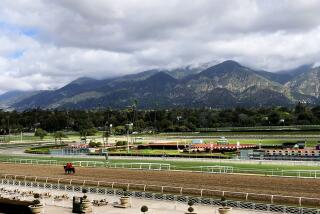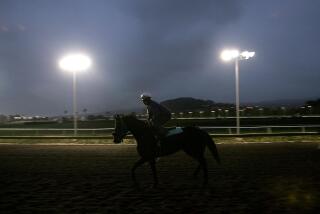Here’s a Race That’s Not for Tenderfoots
- Share via
Here’s the way sports are in the United States. Humans run against humans and horses run against horses.
Right.
But what’s this about a combination of horses and humans running together in a race?
They’ve been doing it for years in Europe and in the last five years it’s become somewhat popular in the western United States.
The horse-human combo is part of ride and tie races in which teams consist of two humans and a horse, usually an Arabian because it’s a long-distance animal. At the start, one partner rides and the other runs. When the rider has gone as far as he thinks his teammate can run, he stops, ties the horse to a tree and takes off on foot.
His teammate runs to the horse and rides for the next stretch. The alternation goes on throughout the race, which can be 25 to 40 miles. Each team has to alternate at least six times, and to win runner and horse have to cross the finish line together.
“It’s great because it’s taking independent runners and making them into a team,” said Steve Shaw, a 37-year old competitor from Manhattan Beach.
Shaw, president of the Ride and Tie Assn., practices in the roads of mountainous Rolling Hills Estates, an area that is home to 4,000 horses. About a dozen others in the area join him.
But even if its popularity has increased in Rolling Hills and there are 75 ride and tie races a year in the United States (seven in California), it’s not as common for a runner to enter a race with his Arabian as it is to watch the action at Hollywood Park or the Boston Marathon.
These are good athletes clad in jock attire and sophisticated running shoes, only their race starts like a mad cavalry charge with herds of horses and humans running side by side in an open field covered by long, dry weeds and patches of crusty dirt.
And unlike a jockey or a marathon runner, ride and tiers have to deal with unusual circumstances.
“You can easily miss your horse if he’s tied in a bad spot where you can’t see him,” Shaw said. “It’s not always easy to find a strong branch that the horse can’t break loose and take off of.”
Shaw recalls a race in which he had a decent lead. He was running at a comfortable pace in the tough country when he suddenly made a U-turn and started sprinting in the opposite direction. He realized after 10 minutes that he had missed Bugs, his horse who was tied to a branch or root somewhere in the rough land.
“It really is an embarrassment when you run past your horse,” he said.
Shaw had signaled his teammate to stop and tie the horse two minutes after he roared past Shaw on the trail. Instead Shaw’s teammate dismounted and started running about a minute early, which threw Shaw off.
There’s another unusual thing competitors have to deal with, says Aileen Johnson, an avid ride and tier who teaches at UCLA.
“It’s a real dirty sport,” she said, dismounting and wiping moist dirt off her running tights, arms and face. “It’s a lot of fun and it’s exciting, but it’s not for people who like to be prim and proper. At the end you’re filthy.”
But competitors do not seem to mind wearing mud after participating in an event that is based on a means of transportation practiced in 17th-Century England and later in the American West when two people had to share one horse.
Westerners discovered it was quicker to have one person ride and the other run behind rather than taking turns riding and walking side by side the entire way.
That’s all it was though, a method of traveling used by our ancestors, until 1971 when the Levi clothing company sponsored the first ride and tie race in California. Bud Johns, president of Levi at the time, saw an unorganized form of ride and tie in the Pine Valley area of California in the late ‘50s. When senior executives of the San Francisco clothing manufacturer were searching for a sporting event that would reflect Levi’s rugged Western image, Johns suggested a ride and tie race.
“It really didn’t make sense to have another golf or tennis tournament,” Johns said.
So Levi sponsored the first ride and tie competition in the Napa Valley. About 66 teams competed on the 24-mile course.
“It was mainly horse people (owners) that participated,” said Johns, who also wrote a ride and tie book in 1985 called “What Is This Madness.” “It was all so new. They were running in cowboy boots.
“It’s changed. Now you have the sophisticated runners and a lot more people participating.”
Ten years later the annual Levi race had 198 competitors and the course was stretched about 10 miles.
“It is becoming popular because it’s a multidisciplined sport,” Johns said. “You have to think every step of the way.
“That’s probably why it attracts people with a high education level, the upscale folks. Dumb jocks don’t do well.”
This activity has been described as grueling, galvanizing and gratifying, and ride and tiers become obsessed with their horses and the rugged land.
For example, Lon Clearwaters, a 46-year-old attorney, sold his house in Manhattan Beach about five years ago so he could live on horse property in Rolling Hills Estates. Clearwaters was a serious distance runner who was introduced to ride and ties by a friend .
“I hadn’t been on a horse since I was a kid,” he said. “But after I saw it (ride and tie), I noticed all the strategy involved and it attracted me.”
Clearwaters has become a gentleman rancher who keeps his four horses in his large backyard. He runs five times a week on nearby hilly trails and rides three times a week to keep in top shape for races.
“When you run,” Clearwaters said, “it’s just you and the distance. “In ride and tie there are so many variables compared to going out and running a foot race.
“I’m enjoying this very much. I’ll do it indefinitely.”
Clearwaters has been involved in ride and ties since 1982, three years after the event made its debut in the South Bay area. That’s around the time Shaw got into it. His stockbroker told him about a “crazy sport” he had heard of and shortly after he met a horse owner who needed a partner.
“That’s the good thing,” said Shaw. “If you don’t have a horse, you don’t really have to buy one. Just find a partner who has one.
“And if you have a horse, all you have to do is find a decent runner and team up.”
The expense is cut because two people can share a horse, but still there is a $75 to $100 entry fee for races and maintenance of the horse, which Shaw says runs about $200 a month.
Most of the smaller ride and tie events do not have prize money. They do reward top finishers with plaques, saddles and belt buckles. The national race, which will be held in the East Bay Regional Park district in San Francisco on June 19, has paid up to $3,000 for first place. Prize money varies according to sponsors.
It’s a good thing then, that money is not why people participate in ride and ties.
“I do it because I love the challenge and I love speed,” said Shaw. “My horse is just my organic motorcycle.”
More to Read
Sign up for Essential California
The most important California stories and recommendations in your inbox every morning.
You may occasionally receive promotional content from the Los Angeles Times.










